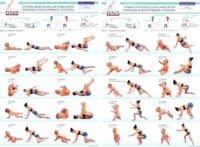 I started taking dance classes years ago, after many rounds of physical therapy for an assortment injuries. I was awkward and clumsy, but I stuck with it for quite a while. I noticed that some of my nagging pains faded and my range of motion increased – even though dance lessons and classes cut into my normal PT and stretching routines. What was going on? How were these series of movements that were new to me helping? Could I simply erase pain through movement?
I started taking dance classes years ago, after many rounds of physical therapy for an assortment injuries. I was awkward and clumsy, but I stuck with it for quite a while. I noticed that some of my nagging pains faded and my range of motion increased – even though dance lessons and classes cut into my normal PT and stretching routines. What was going on? How were these series of movements that were new to me helping? Could I simply erase pain through movement?
After some additional training, I discovered that I had inadvertently made some corrections to a faulty movement program that I had been stuck with since childhood. I also learned that almost all of us are born with the same, nearly perfect, movement program. Over time, most of us unconsciously make changes to this program. This has major implications. Fortunately, for those with two left feet, practicing a series of simple movements can help us reset this program, even more effectively than with dance.
Almost every adult has developed chronic musculoskeletal pain somewhere. It might have been an injury that should have gone away but never quite healed. Perhaps it was a nagging pain that has snuck up on you from poor posture at work. Maybe be an annoying restriction in your range of movement that interferes with your favorite sport or fitness activity.
Faulty Programs
In many cases, we fail to recover because we are using some faulty movement programs. This means that we are no longer moving in a way that is natural and optimal. We have developed a series of compensations and customizations to the movement program we were born with – the same program we were ALL humans are born with.
Normal Developmental Programs
When we see a foal getting up and taking its first steps, it is obvious that it has a program for this. Humans also all have a set movement program, but it is more complex and takes much longer to develop. If you are fortunate enough to have young children in your life you may have several examples of normal movement and development in progress.
Movement Milestones

We closely watch for milestones like the ability to roll over. This actually takes quite a lot of coordination of deep muscles that allow the baby to stabilize its core when it rolls. Occasionally a child experiences a developmental delay or disorder. However, in most cases ALL infants and toddlers move in same basic ways. They have a menu of basic movements that expands as they get older until they can crawl, sit, walk, run, climb and throw.
One of many remarkable things about babies is that they all move in the same way. That is because we all start with the same neuromuscular movement program. Yet, if you look at the general population in any moderately crowded place you will see a virtually unlimited number of variations on the same movements. No two adults move alike. Sometimes we can even recognize someone in the distance or the dark by the movement of their silhouette.
We might call this an aspect of personality. Let’s say it is their Personal Movement Style (PMS). While an interesting personality is often an asset, an “interesting” PMS seldom is. We want our PMS to look much like it did when we were about 3 years old. It should be natural, boring and look pretty much just like everyone else’s.
When our program is disrupted by training, injury or habit, we develop a unique PMS that reflects the series of compensations we have made over time. When someone in pain is not moving in a natural way, it can be hard to know what came first. Is there movement pattern a response to some prior experience of pain or is their current pain a result of the unnatural movement pattern? By the time the problem develops, both are often true, so it makes sense to treat from both angles. Resetting this program will allow you to erase pain through movement.
 Physical and massage therapy are common ways of treating painful muscles and connective tissue that contribute to incorrect movement patterns. Treating taut bands, trigger points and other types of myofascial dysfunction is an important and necessary part of any treatment plan.
Physical and massage therapy are common ways of treating painful muscles and connective tissue that contribute to incorrect movement patterns. Treating taut bands, trigger points and other types of myofascial dysfunction is an important and necessary part of any treatment plan.
However, many trigger point and physical therapists forget that proper movement is its own therapy. Dynamic neuromuscular stabilization is a system that is key to restoring proper movement programs. This type of therapy is based on landmark work done at the Prague School of Rehabilitation. In conjunction with myofascial trigger point therapy it is possible to completely erase pain through movement in many cases of chronic pain.
It is a simple method and it works. We continue to use and improve this approach to treating upper back, neck and shoulder pain with great success. Everyone is different and many of us have additional challenges and complications. We tailor our treatment plans to the individual, but there are common foundations to this work with everyone.
Before you know it, you’ll feel like dancing!
